You are using an outdated browser. Please upgrade your browser to improve your experience.

Math Problem Solving Strategies That Make Students Say “I Get It!”

Even students who are quick with math facts can get stuck when it comes to problem solving.
As soon as a concept is translated to a word problem, or a simple mathematical sentence contains an unknown, they’re stumped.
That’s because problem solving requires us to consciously choose the strategies most appropriate for the problem at hand . And not all students have this metacognitive ability.
But you can teach these strategies for problem solving. You just need to know what they are.
We’ve compiled them here divided into four categories:
Strategies for understanding a problem
Strategies for solving the problem, strategies for working out, strategies for checking the solution.
Get to know these strategies and then model them explicitly to your students. Next time they dive into a rich problem, they’ll be filling up their working out paper faster than ever!
Before students can solve a problem, they need to know what it’s asking them. This is often the first hurdle with word problems that don’t specify a particular mathematical operation.
Encourage your students to:
Read and reread the question
They say they’ve read it, but have they really ? Sometimes students will skip ahead as soon as they’ve noticed one familiar piece of information or give up trying to understand it if the problem doesn’t make sense at first glance.
Teach students to interpret a question by using self-monitoring strategies such as:
- Rereading a question more slowly if it doesn’t make sense the first time
- Asking for help
- Highlighting or underlining important pieces of information.
Identify important and extraneous information
John is collecting money for his friend Ari’s birthday. He starts with $5 of his own, then Marcus gives him another $5. How much does he have now?
As adults looking at the above problem, we can instantly look past the names and the birthday scenario to see a simple addition problem. Students, however, can struggle to determine what’s relevant in the information that’s been given to them.
Teach students to sort and sift the information in a problem to find what’s relevant. A good way to do this is to have them swap out pieces of information to see if the solution changes. If changing names, items or scenarios has no impact on the end result, they’ll realize that it doesn’t need to be a point of focus while solving the problem.
Schema approach
This is a math intervention strategy that can make problem solving easier for all students, regardless of ability.
Compare different word problems of the same type and construct a formula, or mathematical sentence stem, that applies to them all. For example, a simple subtraction problems could be expressed as:
[Number/Quantity A] with [Number/Quantity B] removed becomes [end result].
This is the underlying procedure or schema students are being asked to use. Once they have a list of schema for different mathematical operations (addition, multiplication and so on), they can take turns to apply them to an unfamiliar word problem and see which one fits.
Struggling students often believe math is something you either do automatically or don’t do at all. But that’s not true. Help your students understand that they have a choice of problem-solving strategies to use, and if one doesn’t work, they can try another.
Here are four common strategies students can use for problem solving.
Visualizing
Visualizing an abstract problem often makes it easier to solve. Students could draw a picture or simply draw tally marks on a piece of working out paper.
Encourage visualization by modeling it on the whiteboard and providing graphic organizers that have space for students to draw before they write down the final number.
Guess and check
Show students how to make an educated guess and then plug this answer back into the original problem. If it doesn’t work, they can adjust their initial guess higher or lower accordingly.
Find a pattern
To find patterns, show students how to extract and list all the relevant facts in a problem so they can be easily compared. If they find a pattern, they’ll be able to locate the missing piece of information.
Work backward
Working backward is useful if students are tasked with finding an unknown number in a problem or mathematical sentence. For example, if the problem is 8 + x = 12, students can find x by:
- Starting with 12
- Taking the 8 from the 12
- Being left with 4
- Checking that 4 works when used instead of x
Now students have understood the problem and formulated a strategy, it’s time to put it into practice. But if they just launch in and do it, they might make it harder for themselves. Show them how to work through a problem effectively by:
Documenting working out
Model the process of writing down every step you take to complete a math problem and provide working out paper when students are solving a problem. This will allow students to keep track of their thoughts and pick up errors before they reach a final solution.
Check along the way
Checking work as you go is another crucial self-monitoring strategy for math learners. Model it to them with think aloud questions such as:
- Does that last step look right?
- Does this follow on from the step I took before?
- Have I done any ‘smaller’ sums within the bigger problem that need checking?
Students often make the mistake of thinking that speed is everything in math — so they’ll rush to get an answer down and move on without checking.
But checking is important too. It allows them to pinpoint areas of difficulty as they come up, and it enables them to tackle more complex problems that require multiple checks before arriving at a final answer.
Here are some checking strategies you can promote:
Check with a partner
Comparing answers with a peer leads is a more reflective process than just receiving a tick from the teacher. If students have two different answers, encourage them to talk about how they arrived at them and compare working out methods. They’ll figure out exactly where they went wrong, and what they got right.
Reread the problem with your solution
Most of the time, students will be able to tell whether or not their answer is correct by putting it back into the initial problem. If it doesn’t work or it just ‘looks wrong’, it’s time to go back and fix it up.
Fixing mistakes
Show students how to backtrack through their working out to find the exact point where they made a mistake. Emphasize that they can’t do this if they haven’t written down everything in the first place — so a single answer with no working out isn’t as impressive as they might think!
Need more help developing problem solving skills?
Read up on how to set a problem solving and reasoning activity or explore Mathseeds and Mathletics, our award winning online math programs. They’ve got over 900 teacher tested problem solving activities between them!

Get access to 900+ unique problem solving activities
You might like....
Using success criteria
You are currently:.
- Home
- Tools & resources
- Resource (collection item page) >
The teacher is working towards full registration at the Proficient career stage of the Standards.
- Illustration of Practice
- Context of use
- Discussion questions
School - Melton Primary School
Year level - Year 5 & 6
Related subject - Mathematics
Stage of schooling - Primary
School type - Government
Melton Primary School is located 44km west of Melbourne’s central business district. Melton Primary has developed a Professional Learning Community that is now deeply embedded into the culture of the school. Staff focus on learning rather than teaching, work collaboratively on matters related to learning, and hold themselves, and each other, accountable for the results that fuel continual improvement. Their shared mission, vision, and values are aligned to three big ideas: ensuring that students learn, building and maintaining a culture of collaboration, and focusing on results. Melton Primary School staff meet for an hour each week to engage in collaborative interactions around topics identified by the group, reflect on teaching and learning as part of case study investigations, collaboratively prepare lesson plans, and develop a deeper understanding of how students learn specific subject matter. They then integrate this knowledge into their teaching programs.
- What might be the benefits of identifying explicit success criteria in your lessons?
- What questioning techniques could you use to support students' critical and creative thinking?
- What strategies could you use to collect formative assessment data in your classes?
in this resource pack
Offline package - using success criteria, these resources might interest you as well.
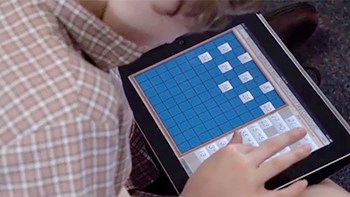
Number patterns
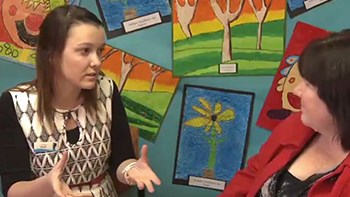
Maths rotations
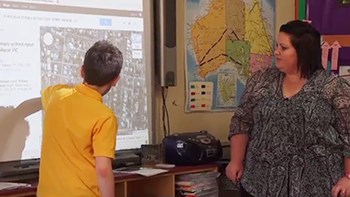
Using and adapting resources
Teach Starter, part of Tes Teach Starter, part of Tes
Search everything in all resources
Mathematics Learning Intention Cards
Updated: 07 Apr 2019
Maths learning intention cards aligned to the Australian Curriculum.
Non-Editable: PDF
Pages: 9 Pages
Years: F - 6
- Foundation (pdf) Sign up to Plus
- Year 3 (pdf) Sign up to Plus
- Year 4 (pdf) Sign up to Plus
- Year 5 (pdf) Sign up to Plus
- Year 6 (pdf) Sign up to Plus
- Year 1 (pdf) Sign up to Plus
- Year 2 (pdf) Sign up to Plus
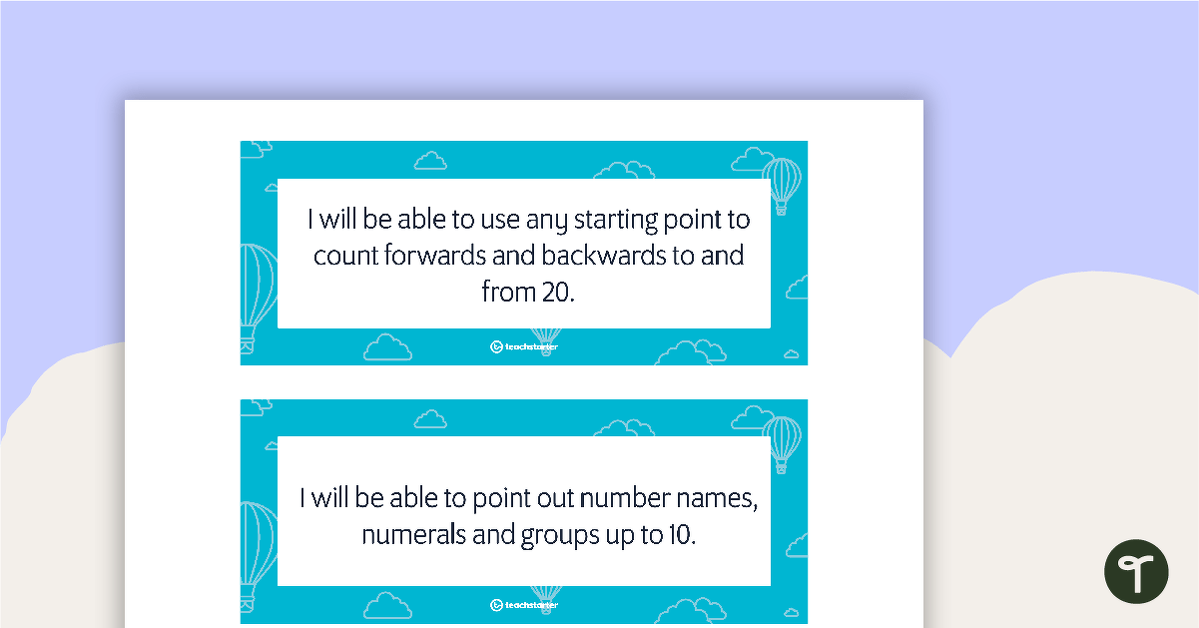
A set of Learning Intention cards, perfect to display in the classroom to promote visible learning and explicitly show students what their learning goals are for a particular concept.
These learning intention cards have been written using the Mathematics Content Descriptions found in the Australian Curriculum v8.3 and have been created to use with our We’re Aiming High – Bump It Up Data Wall Display .
Print off the learning intention card that you wish to focus on with your class then laminate and display at the front of the class or attach it to the Bump It Up Learning Intention poster.
Use these learning intention cards as a generic learning goal then, as a class, determine the success criteria.
Please note that the success criteria for each learning intention card will be different for every class, depending on the ability level of the students. It is important to create the success criteria together as a class from the chosen learning intention card by making a list of the steps required to achieve the goal.
Use this resource with our We’re Aiming High – Bump It Up Data Wall Display .
Teach Starter Publishing
We create premium quality, downloadable teaching resources for primary/elementary school teachers that make classrooms buzz!
14 Comments
Write a review to help other teachers and parents like yourself. If you'd like to request a change to this resource, or report an error, select the corresponding tab above.
No comments yet.
Resource updates
Fixed incorrect wording for Year 1 and 2
Different border colours added to distinguish between year levels.
Suggest a Change
Would you like something changed or customised on this resource? While our team makes every effort to complete change suggestions, we can't guarantee that every change will be completed.
Report an Error
Did you spot an error on this resource? Please let us know and we will fix it shortly.
Are you having trouble downloading or viewing this resource? Please try the following steps:
- Check that you are logged in to your account
- For premium resources, check that you have a paid subscription
- Check that you have installed Adobe Reader ( download here )
If you are still having difficulty, please visit the Teach Starter Help Desk or contact us .
You may also like
- Bump It Up Data Walls →
- Foundation Year →

Base Ten Block Matching Cards (Random Numbers 100 - 1000)
Use these base ten block matching cards to help your students practise number recognition and place value skills for numbers up to 1000.

Place Value Cards - 10 000, 1000, 100, 10, 1
A set of place value cards to help students explore and expand larger numbers.
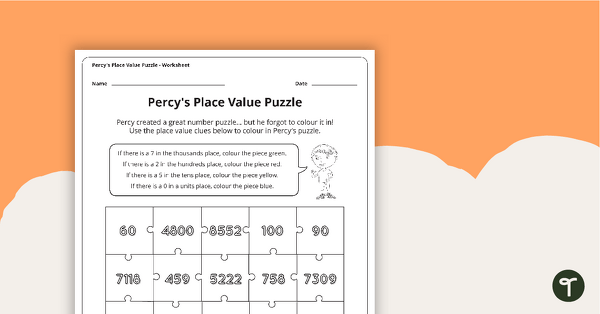
Percy's Place Value Puzzle
A worksheet to use to consolidate student understanding of place value to the thousands.

Identifying and Naming Angles – Cut-and-Paste Worksheet
Identify acute, right, obtuse, straight, reflex and revolution angles with this cut-and-paste sorting worksheet.

Piggy Bank Pigs - Australian Coins
Piggy Bank Pigs are a fun, hands on way for students to learn each of the coins and how their values add up to a certain amount.

Desk Plate Alphabet and Number Line - Butterflies and Lady Bugs
Lower Grade Desk Plates with the alphabet, number line and student's name on them.
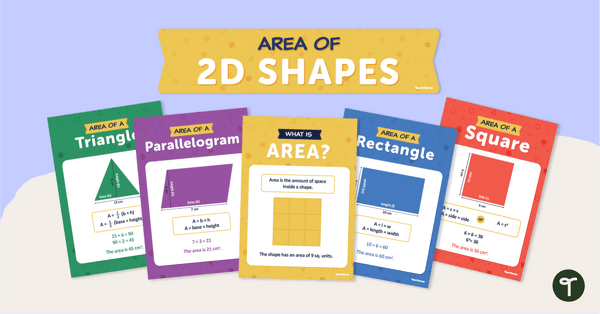
Area of 2D Shapes Posters
Area of 2D Shapes - so many rules and formulas to remember!

Location Maths Investigation - Blackbeard's Bounty
A mathematics investigation about location, embedded in a real-world context.

Area And Perimeter Task Cards
Use these area and perimeter task cards in your maths lessons to give your students practice solving real-world word problems.
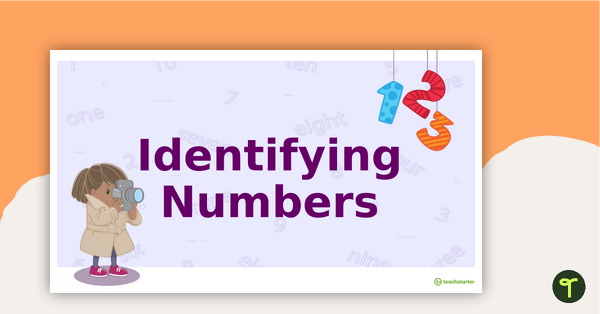
Identifying Numbers PowerPoint
A 14 page editable PowerPoint presentation to use when teaching number recognition to younger students.

- Big Ideas Login
- Request a Sample

Big Ideas Learning’s Mathematics Teaching Practices Series: Establishing Mathematics Goals to Focus Learning
- Sophie Murphy

In this series, we will explore the eight research-based essential Mathematics Teaching Practices found in NCTM’s Principles to Actions. Today’s blog focuses on the first essential Mathematics Teaching Practices: establishing mathematics goals to focus learning.
2020 has brought many different challenges to teaching and learning across the globe. It has been fast. It has been sudden. It has been a first for an entire generation. Teaching has shifted from learning in schools to remote and distan ce learning from home. Despite this shift, we as educators are responsible for continuing to provide quality learning opportunities for our students.
Across the globe, whatever learning environment we face – online/remote learning or back in the classroom – two major questions remain:
- How do we support our students and teachers in this new world of education?
- How do we continue to support students when shift ing from online/remote learning to face - to - face learning and then back to online learning at any given time?
For me, taking an evidence-based approach is an important first step. It brings to light what we know works and provides an important stepping - stone in supporting teachers with impactful teaching practices. In this series, we will explore the eight research-based essential Mathematics Teaching Practices found in NCTM ’s Principles to Actions . Each blog will connect t he recommendations from NCTM to the mathematics classroom and show how the evidence-based research supports online/remote and in - school learning environment s .
Mathematics Teaching Practice #1 – Establishing mathematics goals to focus learning
Today’s blog focuses on the first of NCTM’s eight research-based essential Mathematics Teaching Practices: establishing mathematics goals to focus learning . NCTM believes that in order to achieve this, t eachers and students carry out specific roles .
Teachers must:
- Establish clear goals that articulate the mathematics that students are learning as a result of instruction in a lesson, over a series of lessons, or throughout a unit.
- Identify how the goals fit within a mathematics learning progression.
- Discuss and refer to the mathematical purpose and goal of a lesson during instruction to ensure that students understand how the current work contributes to their learning.
- Us e the mathematics goals to guide lesson planning and reflection and make in the moment decisions during instruction.
Students must:
- Engag e in discussions of the mathematical purpose and goals related to their current work in the mathematical classroom . (e x . What are we learning? W hy are we learning it? )
- Us e the learning goals to stay focused on their progress in improving their understanding of mathematical content and proficiency in using mathematical practices.
- Connect their current work with the mathematics that they studied previously to understand where the mathematics is going.
- Assess and monitor their own understanding and progress toward accomplishing the mathematics learning goals.
Research Behind Goal Setting
In my last blog, I discussed the impact of Professor John Hattie's extensive meta-analysis of thousands of research findings and how this can be used and interpreted within a school context. One area of research that Professor Hattie demonstrates is essential in all teaching settings is goal setting, which he notes has an effect size of 0 .56 ( 0 .4 being a year’s worth of growth for a year’s worth of schooling).
Professor Christine Rubie-Davies from the University of Auckland has studied the importance of high expectations and goal setting and the positive impact they ha ve when done in an effective way for students. She believes that all students must be given difficult, yet achievable learning goals to be motivated . T he importance of establishing challenging goals rather than 'do your best' goals – whether online or in the classroom – cannot be underestimated. By setting challenging goals, the teacher develops and maintains a culture of high expectations.
How can teachers effectively set learning goals that challenge all students?
Learning intentions and success criteria .
Lessons need to include clear learning intentions with goals that clarify what success looks like. They should explain what students need to understand and what they should be able to do. This helps teachers plan learning activities and helps students understand what is required. Professor John Hattie ’s research shows that having c lear learning intentions and success criteria also help students track their own progress and more easily identify where they may need additional support to succeed. When teachers set and communicate clear lesson goals to help students understand the success criteria, students know where they are, where they need to go and how they are going to get there .
You can find examples of Learning I ntentions (also known as Learning Targets) and S uccess C riteria in the Big Ideas Math series . These align to the learning in the series and teaching notes and provide teachers with a great starting point in setting goals and creating clarity when teaching and learning mathematics . Hattie (2012) believes that the key to setting learning goals and provid ing success criteria is to help students commit to the learning and provide the appropriate mix of success and challenge. Further more , by explaining the connections between learning goals, learning activities , and assessment tasks, teachers demonstrate the purpose of classroom tasks, making the learning visible to students. This helps students become self-motivated to use learning goals to monitor their learning progress .
Students feel supported when t eachers help break their larger goals down into small, achievable steps that they can work through and evaluate each step throughout the year. Hattie (2012) believes that self-evaluation is considered one of the key benefits of ‘Goal Setting’ as a strategy because it encourages students to provide the evidence that they think demonstrates how they achieved their goals, while also recogni z ing the areas in which they need to improve.
In order for students to be actively involved in the process, the learning intentions and success criteria need to be visible at all times so that both the students and teachers can refer to them throughout each lesson. Learning goals should also be achievable for students of varying abilities and characteristics. However, this does not mean that students will have different learning intentions and success criteria.
Feedback
The value of learning goals extends beyond a checklist of content/skills covered . T hey provide students with a focus and a chance to receive feedback which is a powerful force in improving student outcomes. Feedback can occur in assessing the learning goal at the start and end of the lesson. This encourages students to take control of their learning and engage s them in meta - cognitive processes (Hattie, 2012).
Assessment
Assessment must be authentic to provide teachers with evidence of prior learning, and the information they need to set goals that offer each student the appropriate level of challenge. Assessment tasks must be appropriate for each student as she/he demonstrate s knowledge and skills at many different levels. Using a framework such as the SOLO Taxonomy , Bloom ’ s Taxonomy , or Depth of K nowledge (DOK) ensure s that tasks include lower and higher order understanding, skills , and knowledge at different levels .
Key takeaways
In the unknown world of teaching and learning in 2020 , one thing is for sure : goal setting can be used in all environments and is an essential tool for teachers to provide students with support to let them know where they are in their learning, where they need to go , and how they are going to get there.
When setting mathematics learning goals, keep th ese tips in mind:
- When teachers use goal setting as a strategy, s tudents can self-monitor their progress and take ownership of their learning when they have clear learning goals to work towards .
- Clear goals and small steps toward larger goals provide evidence to both the students and teachers that they need to continue to demonstrate that they achieved their goals , understand any misconceptions , and work together toward the learning goal .
- When students understand their goals and know how to work towards their goals, they can make greater connections not only with the learning goals, but with the learning activities and assessment t asks .
- L earning goals can actively engage students in identifying strengths and areas for improvement o f their own learning to frame future learning goals, understandings , and aspirations.
We will continue to share with you practical examples and connections to the NCTM evidence - based M athematics T eaching S trategies that will impact all classroom environments . Stay safe and well. Remember, you are doing a great job! Keep in touch, ask any questions or comment via twitter ( @_sophie_murphy_ ) and through Big Ideas Learning and National Geographic Learning . I look forward to connecting with you all again soon.
Sophie
References:
Hattie, J. (2012). Visible learning for teachers: Maximizing impact on learning . Routledge, NY.
National Council of Teachers of Mathematics. (2014). Principles to actions: Ensuring mathematical success for all . Reston, VA: Author.
Rubie-Davies C, Hattie J, Hamilton R. Expecting the best for students: teacher expectations and academic outcomes. The British Journal of Educational Psychology . 2006 Sep:429-444
Related Articles
Interview with laurie boswell: supporting math educators.
Topics: Resources , Professional Development , Student Engagement
10 Summer Reads for Teachers
Topics: Resources , Professional Development , Educator Empowerment
Big Ideas Learning’s Mathematics Teaching Practices Series: Implementing Tasks That Promote Reasoning and Problem Solving
Topics: Professional Development
- STEM Ambassadors
- School trusts
- ITE and governors
- Invest in schools
- Student programmes
- Benefits and impact
- Our supporters
- Advertising and sponsorship
- Become a STEM Ambassador
- Request a STEM Ambassador
- Employer information
- Training and support
- STEM Ambassadors Partners
- Working with community groups
- Search icon
- Join the STEM Community
John Hattie: Learning intentions and success criteria
John Hattie explains the importance of sharing learning intentions.
The basic premise is that the students have the same idea as their teacher what is going on in the classroom, and what they should be learning as a result of doing. Many students are not going to know this unless it is clearly signposted - learning intentions (or objectives), and learning outcomes (or success criteria) provide this direction.
You could try several different ways to share and even co-construct success criteria with students for maximum impact:
1. Doing it wrong so the students correct you, or not completing them, so that they do.
2. Show a finished product, so that they can see what a good one looks like
3. A comparison of two products is even better as it gives an indication of quality (why is this one better than that one?).
4. Sloppy success criteria giving rise to incorrect methods or work. The students then decide together how to make the success criteria better.
5. Retrospective creation of success criteria is useful when the product or process is so big it’s not immediately obvious what went into it. This is especially useful in breaking down aspects of enquiry.
6. Revisiting existing success criteria, to see if you can make it better.
Active Learning Through Formative Assessment (Clarke, S. 2008) gives a great description of how you can use learning intentions and success criteria
https://www.youtube.com/watch?v=OGyvDvOegXE
Show health and safety information
Please be aware that resources have been published on the website in the form that they were originally supplied. This means that procedures reflect general practice and standards applicable at the time resources were produced and cannot be assumed to be acceptable today. Website users are fully responsible for ensuring that any activity, including practical work, which they carry out is in accordance with current regulations related to health and safety and that an appropriate risk assessment has been carried out.
| Subject(s) | Cross curricular |
|---|---|
| Age | n.a |
| Published | 2010 to 2019 |
| Published by | |
| Direct URL |
Share this resource
Did you like this resource.
- News & Calendar
- Career Center
- Get Involved
- Notice and Wonder
- Illuminations
- Problems of the Week
- Problems to Ponder
- Innovative Lessons and Activities
- Classroom Conversations
- Tips for Teachers
- Math Sightings
- Video Lessons
- Back to School Resources

- Featured Books
- Mathematics Teacher: Learning and Teaching PK-12
- Journal for Research in Mathematics Education
- Mathematics Teacher Educator
- Institutional Subscriptions
- Rights and Permissions
- Write, Review, Referee
- Legacy Journals and Blogs
- Principles to Actions
- Position Statements
- Catalyzing Change
- Standards for Mathematics Teacher Preparation
- Curriculum Focal Points
- Focus in High School Mathematics
- NCTM Standards
- Policies and Recommendations
- Advocacy Toolkit
- Advocacy and Legislation
- ESSER - District Solutions
- Every Student Succeeds Act - ESSA Toolkit
- NCTM Social Justice and Equity Resources
- Research Briefs & Clips
- Linking Research & Practice
- Research Conference
- Research Monographs
- Continuing the Journey
- NCTM Annual Meeting & Exposition
- Professional Development Resources
- Spring Conference
- Virtual Conference
- Interactive Institutes
- Speaking at NCTM Events
- Professional Services
- NCTM District Solutions
- NCTM Teacher Education Program Review Training
- NCTE-NCTM Joint Conference on Elementary Literacy & Mathematics
- Exhibit, Advertise, Sponsor
- Funding Opportunities
- About Mathematics Education Trust
- Browse All Grants
- Giving Opportunities
- Special Events
- Lifetime Achievement Award
- Social Justice and Mathematics
- Individuals
- Schools and Districts
- Group Content Access
Problem Solving
This is available to members of NCTM. Please log in now to view this content. If you are interested in a NCTM membership join now .
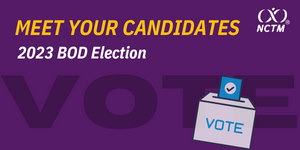
- Advertise with NCTM
- Exhibit and Sponsor
- For the Media
- Terms of Use
- Privacy Policy
- Code of Conduct
LESR Pedagogical Model
( challenging math ematical tasks).
We have known for a long time that reading is a complex problem-solving activity. More recently, teachers have come to understand that becoming mathematically literate is also a complex problem-solving activity that increases in power and flexibility when practised more often. A problem in mathematics is any situation that must be resolved using mathematical tools but for which there is no immediately obvious strategy. If the way forward is obvious, it’s not a problem– it is a straightforward application (Klerlein and Hervey, 2022).
What is the Launch, Explore, Summarise, Re-Launch Framework (Challenging Tasks)?
'The best teachers are those who show you where to look but don't tell you what to see.'
Alexandra K. Trenfor
The Launch, Explore, Summarise instructional model supports the idea that students learn best when they work on problems that they do not yet know how to solve. This type of learning does not diminish the role of the teacher. Rather the teacher plays a critical function in the lesson by guiding learning, highlighting important concepts and uncovering and making explicit any misconceptions so that they can be addressed appropriately.
Peter Sullivan’s research shows that many students do not fear challenges in mathematics but welcome them. And rather than having teachers instruct them, these students prefer to work out solutions for themselves.
Peter believes " learning will be more robust if students connect ideas together for themselves, and determine their own strategies for solving problems, rather than following instructions they have been given. Both connecting ideas together and formulating their own strategies is more complex than other approaches and is therefore more challenging. It is potentially productive if students are willing to take up such challenges."
Launch, Explore, Summarise Framework requires students to:
plan their approach, especially sequencing more than one step;
process multiple pieces of information, with an expectation that they make connections between those pieces, and see concepts in new ways;
choose their own strategies, goals, and level of accessing the task;
spend time on the task and record their thinking; and
explain their strategies and justify their thinking to the teacher and other students.
At least part of the challenge is the expectation that students:
record the steps in their solutions;
explain their strategies;
justify their thinking to the teacher and other students; and
listen attentively to one another.
The optimal tasks are those that address important mathematical ideas that are developmentally appropriate and with which there is a reasonable expectation that students can engage with minimal instruction.

Common Misconceptions
Zone of Confusion
Peter Sullivan uses the Launch, Explore, Summarise Framework to illustrate how to teach using a problem-solving approach. While lesson sequences should be challenging, Peter discusses launching the task so that students are within their "zone of confusion" . This does not mean that students should be experiencing learning that is beyond their capability, merely that the task requires deep thinking to solve. It cannot be solved yet !
The task should be challenging and pitched within students' zone of proximal development , where students can actively engage in attempting to solve the problem with minimal initial input from the teacher.
Problem-solving and the place of the teacher
Problem-solving is a complex process that develops over time and with careful planning on the part of the teacher.
There are three ways in which teachers can support the development of problem-solving skills.
Through our choice of task
Through structuring the stages of the problem-solving process
Through explicitly and repeatedly providing children with opportunities to develop key problem-solving skills (Pennant, 2019).
Each of these considerations involves teachers' active involvemen t in selecting appropriate tasks and creating the conditions in the classroom that support productive mathematics learning .
Explicit Teaching
The Launch, Explore, Summarise Framework explains that students be provided with a rich task that they don't know yet how to solve and that they begin the lesson with minimal instruction. However, this does not negate the involvement of the teacher. During the Launch section of the framework, the teacher:
orientates students to the task,
unpacks the vocabulary,
ensures that students have read the problem and
ensures that students are familiar with any manipulatives that are made available to complete the task.
We are familiar with the Gradual Release of Responsibility Model (I do, we do, you do model) of instruction, first outlined by Pearson and Gallagher (1983) and expanded on in the research of Fisher and Frey (2006). While this is an evidence-based instructional model based on the acquisition of reading comprehension skills, mathematics instruction is different . This does not mean that Challenging Tasks omits the use of modell ing , and guid ing students , nor does it mean that worked examples are redundant.
Rather, worked examples are unpacked and modelling of concepts occurs in a different way. Aylie Davidson (2022) has created a valuable visual representation ( RIGHT ) of how the Launch, Explore, Summarise Framework can be assimilated with modelled, guided and independent teaching strategies.
Professional Readings
Peter Sullivan gives his top 3 tips for using Challenging Tasks in the classroom.
1. Experience before instruction
2. Less teacher talk
3. The importance of students sharing their thinking
Click above to gain access to diocesan challenging task site.
James Russo, one of the researchers behind the EMC 3 Project has created the following site 'SURF Maths' to share investigations and rich tasks that can be used within the LESR Pedagogical Framework.
James describes his research interests as:
To make mathematics more enjoyable to teach and learn;
To explore the connections between research and practice;
To undertake experimental research in actual classroom settings (Russo, 2020).
Some examples of James Russo's tasks can be found below, with many similarly presented tasks on the site link ( left ).
References:
Bobis, J., Russo, J., Downton A., Feng, M. , McCormick, M., and Sullivan, P. (2021). Instructional Moves that Increase Chances of Engaging All Students in Learning Mathematics . https://www.researchgate.net/publication/349945179_Instructional_Moves_that_Increase_Chances_of_Engaging_All_Students_in_Learning_Mathematics
Klerlein, and Hervey (2022). Mathematics as a Complex Problem-Solving Activity . https://www.generationready.com/white-papers/mathematics-as-a-complex-problem-solving-activity
Livy, S., Muir, T., and Sullivan, P. (2018). Challenging Tasks Lead to Productive Struggle! https://www.researchgate.net/publication/337322262_Challenging_tasks_lead_to_productive_struggle
Russo J. (2020). Designing and scaffolding rich mathematical learning experiences with challenging tasks. https://www.researchgate.net/publication/339616543_Designing_and_scaffolding_rich_mathematical_learning_experiences_with_challenging_tasks
Russo J. and Sullivan, P. (2022). Teaching with challenging tasks: Does it fit with high impact teaching strategies? https://www.researchgate.net/publication/350895121_Teaching_with_challenging_tasks_Does_it_fit_with_high_impact_teaching_strategies
Sullivan, P. (2018). Exploring the potential for using challenging mathematical tasks . Retrieved from https://sites.google.com/dow.catholic.edu.au/challengingmaths/home
University of North Carolina Greensborough (20 18). Launch, explore, discuss lesson framework . https://tools4ncteachers.com/resources/4-fourth-grade/additional-resources/cluster-1/brieflaunchexplorediscusslesson.pdf
- Our Mission
There has been an error with the video.
Using a Plan of Attack for Math Problem-Solving
Spending the majority of their time modeling problems and making sense of relationships in math can help students move beyond a surface-level grasp.
At every grade level, math teachers in the Success Academy Charter Schools Network in New York City ask students to spend the lion’s share of their time during math lessons deeply examining the question they are being asked to solve. Students start by asking themselves questions like, “What are the mathematical relationships in the problem?” “What is this problem asking me to do?” and “How can I model my thinking?” Every classroom even has a formula—a problem-solving plan for math, printed out and displayed on the wall—called the “Plan of Attack,” which includes three parts: using 80 percent of the allotted time to conceptualize the question by reading the problem multiple times, then modeling the relationships and actions in the problems; 10 percent to answer the question by determining a strategy they will use to solve it and then computing; and finally double-checking in the last 10 percent of their time—by rereading the problem, evaluating their own reasoning, and checking computations for accuracy.
First-grade teacher Evelyn Gonzales and eighth-grade teacher Fei Liu both reinforce this strategy during precious class time by working through the problem as a whole with their students first, emphasizing the importance of this step before rushing in to solve. As a result, their students develop a much stronger understanding of the mathematical concepts at hand. “In my classroom, I don’t really care for the answer,” says Liu. “They can double-check once they have the answer. What we really need to focus on is why we set the things up, so that when they see a problem, they have an idea of where to start to think.”
The network led the state for math test scores in the 2023–2024 school year, with with 49 percent of Black and 55 percent of Hispanic students earning fours, the highest possible mark.
See all of Edutopia’s coverage of Success Academy Charter Schools to learn more about the network.
Success Academy Charter Schools
- About Math+Literacy
- Testimonials
- A Year’s Worth of Learning Intentions & Success Criteria for Number Talks
- Visible Learning

- July 7, 2020 |
- Math+Literacy, LLC |
- Routines , Visible Learning |
Sometimes the idea of creating and communicating meaningful learning intentions and success criteria for every part of our instructional day is overwhelming.
From the moment learners enter our classroom door, they are engaged in intentional learning experiences. Some of these experiences are part of purposefully short, frequent tasks or routines that provide structure to meaningful, spaced practice, such as Number Talks, Quick Images, Which One Doesn’t Belong?, Counting Jars, Visual Estimation, and Notice and Wonder.
Creating and communicating meaningful learning intentions and success criteria for these routines can be daunting. It feels as though the learning intentions and success criteria could take up more time than the brief task itself. And planning 180 learning intentions and success criteria for short routines would be incredibly time-consuming.
On the other hand, we know communicating teacher clarity is pivotal to effective teaching (effect size = 0.75). We want learners to articulate what they are learning , why they are learning it , and how they will know when they are successful . An effective way to communicate teacher clarity is through learning intentions and success criteria. Learning intentions describe what we want our students to learn (effect size = 0.68) and success criteria specify the evidence learners will produce to show their progress toward mastering the learning intention (effect size 1.13). (Almarode, Fisher, Thunder, Hattie, & Fry, 2019)
So how do we efficiently and effectively create learning intentions and success criteria for math routines?
Our answer: Think big picture. Create year-long learning intentions and success criteria.
Rather than think about our learning goals for each day, week or unit’s Number Talks, we think about our learning goals for the whole year. We ask ourselves: By engaging in Number Talks multiple times each week, what are students learning? Why are they learning this? And how will they know when they are successful?
With the whole year in mind, we create three sets of learning intentions: content, language, and social learning intentions.
- Content Learning Intentions communicate the mathematical content of the learning or the mathematical “what”.
- Language Learning Intentions communicate the mathematical vocabulary and phrases students need to know to master the mathematical content.
- Social Learning Intentions communicate the social skills that foster effective collaboration and communication. Together, Language and Social Learning Intentions communicate the mathematical “why” or the mathematical practices and processes for learning the content.
To create our Content Learning Intentions, we focus on the four main purposes of our Number Talks throughout the year:
- growing fluency with part-part-whole relationships (We are learning to see combinations of __.) ,
- growing fluency with one/two/ten more or less (We are learning to see __ more and __ less.) ,
- subitizing (We are learning to see the quantity fast.) , and
- developing number sense through benchmarks of five and ten (We are learning to see the largest group.) .
To create our Language Learning Intentions, we examine the mathematical vocabulary learners need to transfer from Number Talks to other mathematical problem solving tasks. We ask ourselves, “What words are important for talking and thinking about the mathematical content?”
To create our Social Learning Intentions, we consider why we value this significant, yet brief, whole group instruction so much. We ask ourselves, “Why is it valuable for all of our students to work, think, and talk together as a math community in a Number Talk?” Again, we examine the social skills for collaboration and communication that learners need to transfer from Number Talks to other learning tasks.
Here are our learning intentions for a year of Number Talks in PreK and Kindergarten:
| Content Learning Intentions | We are learning to see combinations of __. We are learning to see __ more and __ less. We are learning to see the quantity fast. We are learning to see the largest group. |
| Language Learning Intentions | We are learning to describe combinations, how many more and less, groups, and values. We are learning to prove our reasoning using the words: parts, wholes, missing parts, empty spaces, groups, sets, values, and total. |
| Social Learning Intentions | We are learning to listen to, make connections to, and build on peers’ ideas. We are learning to respectfully agree and disagree. We are learning to use peers’ ideas to try new ways of thinking. |
Now, we can select one content, language, and social learning intention for each Number Talk and quickly create aligned success criteria. We vary our wording but keep the heart of the learning intentions and success criteria the same over time to help learners’ develop meaning through familiarity. We adjust the numbers, representations, tools, questions, and language frames to create novelty and engagement. And we keep it brief when we communicate the learning intentions and success criteria to learners so the learning task remains central.
Here are two examples:
Alisha’s Kindergarten class:
Alisha planned three Number Talks over the course of one week. The learning intention for all three Number Talks was, “We are learning to see combinations of 7.” The success criteria for the first Number Talk using ten-frames was, “I can share how my friend saw seven.” The second Number Talk used domino dot patterns and the success criteria was, “I can compare how our thoughts are the same and different.” And the final Number Talk of the week’s success criteria was, “I can use a friend’s strategy,” using rekenreks.
Kateri’s PreK class:
Kateri planned two Number Talks over the course of one week. The learning intention for both Number Talks was, “We are learning to identify how many dots by noticing how many are empty,” and “We are learning to listen to friends’ ideas.” The success criteria for both Number Talks was, “I can name the total dots by first looking at the empty spaces,” and “I can notice if I saw the same empty spaces as my friends.” For the first Number Talk, they used ten-frames with 0 and 1 empty spaces in different locations. For the second Number Talk, they again used ten-frames but with 0, 1, and 2 empty spaces in different locations.
As we begin thinking about how to use what we know about math routines in new learning settings – whether in-person, virtual, or hybrid, we know that communicating learning intentions and success criteria will remain a significant instructional practice. We believe relying on year-long learning intentions and success criteria for math routines will create a sense of continuity and purpose that will be imperative for us, our students, and their families.
For more about Math Routines and our work to prepare for teaching and learning in-person, virtually, and hybrid: Register for the 2020 Math+Literacy Summer Series Institute – a series of 4 webinars.
For more about communicating clarity in the early childhood mathematics classroom: Check out our guest blog for Corwin .
Related Posts

Recent Posts
- Examining Discretionary Space in Our Classrooms: Read Alouds
- Diversifying the Books on Our Shelves: If you like…Then also try….
- To Night Owl From Dogfish
- Peas & Carrots: A New Twist to an Old Task
- August 2020
- February 2020
- February 2019
- January 2019
- December 2018
- November 2018
- October 2018
- Academic Choice
- Children's Literature
- Goal Setting
- Progress Monitoring
- Teaching for Justice
- The Math Diet
- Uncategorized
- Workshop Model
- Entries RSS
- Comments RSS
- WordPress.org
- The Math Diet in Teaching Children Mathematics
- The Math Diet: An Instructional Framework to Grow Mathematicians

Teaching the F-2 ACARA Math Learning Intentions Through Play
Our young children need to learn through play. They learn best through play. So how can we effectively teach all the F-2 ACARA math learning intentions the most effective way? Through play!!
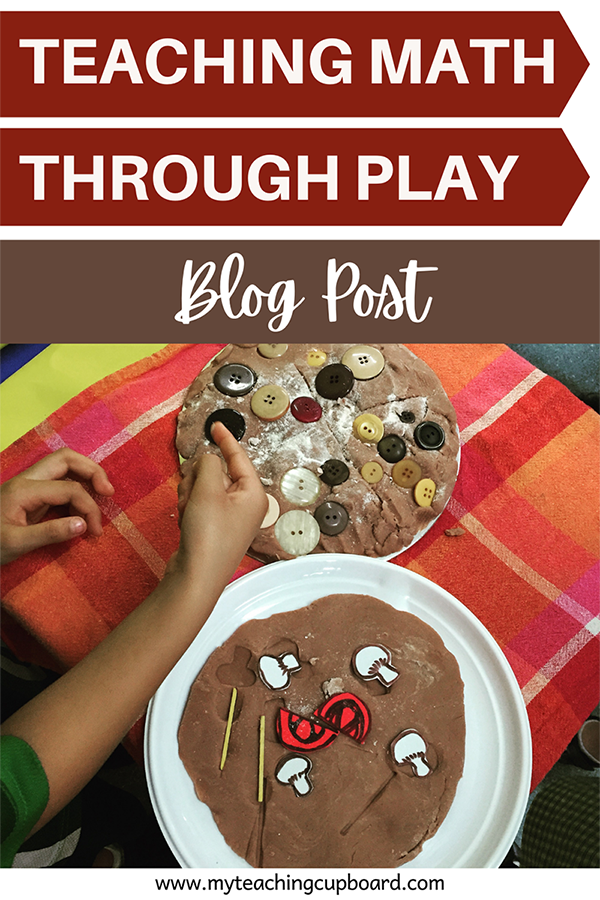
As an early years teacher, you know early numeracy has nothing to do with rote memorization. It has everything to do with hands-on experiences, conversations, thinking, and problem solving.
Our goal in teaching maths is to create opportunities where our early years students are enjoying their math learning journey by using hands-on materials to build deep conceptual math understanding through play.

We are building the foundational math concepts and understandings children will base all their future math learning on, so we need to get it right. We need to focus on teaching mathematical concepts and strategies through age-appropriate math play.
And perhaps most importantly, we need to provide real world hands-on opportunities of math experiences in a fun and playful way so we can effectively nurture our children’s love of maths.

So let’s look a little closer at our F-2 ACARA Math Curriculum and discover ways we can teach ALL the math learning intentions through play.
The Australian Math Curriculum
The Australian math curriculum has 3 overarching aims.
To create students who are confident, creative users and communicators of mathematics, able to investigate, represent and interpret situations in their personal and work lives and as active citizens.
To develop an increasingly sophisticated understanding of mathematical concepts and fluency with processes and are able to pose and solve problems and reason in number and algebra, measurement and geometry, and statistics and probability.
To recognise connections between the areas of mathematics and other disciplines and appreciate mathematics as an accessible and enjoyable discipline to study.
ACARA builds on the key learning outcomes of the national Early Years Learning Framework. Both these guidelines acknowledge the power of play. They state play to be the most useful and most age-appropriate tool for literacy and numeracy learning.

After teaching in the F-2 grades for many years, I have noticed the way this age group learns best is not the same as for children in the upper grades. It is one of the reasons I support play-based learning in early childhood.
When we provide opportunities for children to investigate and learn through play, we are fostering authentic literacy and numeracy .
Teaching Numeracy
Understanding what numeracy is and what it should look like in our classrooms is the first step in teaching math through play-based learning.
‘Numeracy is the capacity, confidence and disposition to use mathematics in daily life. Children bring new mathematical understandings through engaging with problem solving. It is essential that the mathematical ideas with which young children interact are relevant and meaningful in the context of their current lives. Educators require a rich mathematical vocabulary to accurately describe and explain children’s mathematical ideas and to support numeracy development. Spatial sense, structure and pattern, number, measurement, data argumentation, connections and exploring the world mathematically are the powerful mathematical ideas children need to become numerate.’ (EYLF, 2009, p. 38)
So, if we are to teach math authentically and provide relevant and meaningful experiences, we must deliver a rich range of learning opportunities that provide experiences for children to be creative , to think , and to problem solve . And on top of that, these experiences must be ‘ meaningful ’ to the child.
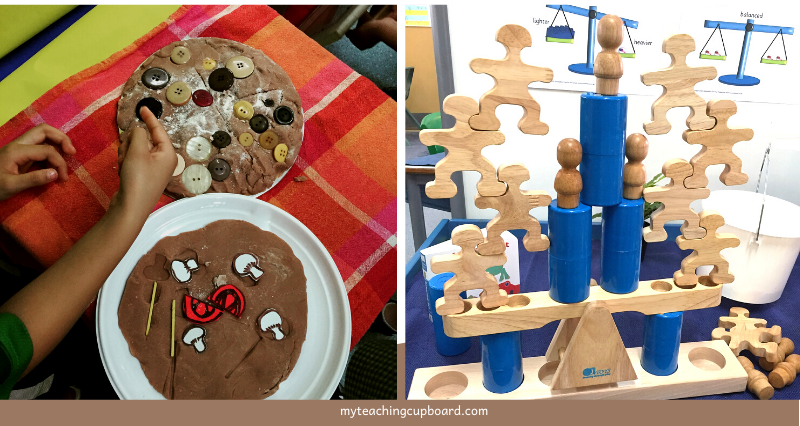
It seems there is no better way to teach numeracy than through the rich range of learning opportunities we provide in our intentionally designed and purposeful investigation areas. Children exploring our play based investigation areas are consistently creating, thinking and problem solving.
The most significant strategies to promote early literacy and numeracy are in fact through play because it is clear that in the early years, children learn numeracy best through hands-on investigative play experiences.
So now let’s look at the content strands of the Australian curriculum because they describe the content we need to be teaching to our F-2 grades.
The Three Content Strands of ACARA
The Australian Mathematics Curriculum is organised around the interaction of three content strands and four proficiency strands.
The content strands are
Number and Algebra
Measurement and geometry, statistics and probability.
Number and algebra are developed together, as each enriches the study of the other. Students apply number sense and strategies for counting and representing numbers. They explore the magnitude and properties of numbers. They apply a range of strategies for computation and understand the connections between operations. They recognise patterns and understand the concepts of variable and function. They build on their understanding of the number system to describe relationships and formulate generalisations. They recognise equivalence and solve equations and inequalities. They apply their number and algebra skills to conduct investigations, solve problems and communicate their reasoning.

Measurement and geometry are presented together to emphasise their relationship to each other, enhancing their practical relevance. Students develop an increasingly sophisticated understanding of size, shape, relative position, and movement of two-dimensional figures in the plane and three-dimensional objects in space. They investigate properties and apply their understanding of them to define, compare and construct figures and objects. They learn to develop geometric arguments. They make meaningful measurements of quantities, choosing appropriate metric units of measurement. They build an understanding of the connections between units and calculate derived measures such as area, speed, and density.

Statistics and probability initially develop in parallel and the curriculum then progressively builds the links between them. Students recognise and analyse data and draw inferences. They represent, summarise, and interpret data and undertake purposeful investigations involving the collection and interpretation of data. They assess likelihood and assign probabilities using experimental and theoretical approaches. They develop an increasingly sophisticated ability to critically evaluate chance and data concepts and make reasoned judgements and decisions, as well as building skills to critically evaluate statistical information and develop intuitions about data.

The Australian Mathematics Curriculum is organised so that these three content strands are intertwined and integrated with the key ideas and understandings of four proficiency strands.
This integrated approach has been adopted to ensure students’ proficiency in mathematical skills develops throughout the curriculum and becomes increasingly sophisticated over the years of schooling.
The Key Ideas and Understandings of ACARA Maths
The key ideas and understandings of the ACARA Math Curriculum are closely integrated and should be taught in an integrated way. Play based investigations are ideal for integrating the content strands and the key ideas.
In Mathematics, the key ideas are the proficiency strands of understanding, fluency, problem-solving and reasoning. The proficiency strands describe the actions (or the doing) in which students can engage when learning and using the math content.
Not all proficiency strands apply to every content description, but they do indicate the breadth of mathematical actions that teachers can support through play based learning.

Understanding
Students build a robust knowledge of adaptable and transferable mathematical concepts. They make connections between related concepts and progressively apply the familiar to develop new ideas. They develop an understanding of the relationship between the ‘why’ and the ‘how’ of mathematics. Students build understanding when they
· connect related ideas
· represent concepts in different ways
· identify commonalities and differences between aspects of content
· describe their thinking mathematically
· interpret mathematical information
Students develop skills in choosing appropriate procedures; carrying out procedures flexibly, accurately, efficiently, and appropriately; and recalling factual knowledge and concepts readily. Students are fluent when they
· calculate answers efficiently
· recognise robust ways of answering questions
· choose appropriate methods and approximations
· recall definitions and regularly use facts
· can manipulate expressions and equations to find solutions
Problem-solving
Students develop the ability to make choices, interpret, formulate, model, and investigate problem situations, and communicate solutions effectively. Students formulate and solve problems when they
· use mathematics to represent unfamiliar or meaningful situations
· design investigations and plan their approaches
· apply their existing strategies to seek solutions
· verify that their answers are reasonable
Students develop an increasingly sophisticated capacity for logical thought and actions, such as analysing, proving, evaluating, explaining, inferring, justifying, and generalising. Students are reasoning mathematically when they
· explain their thinking
· deduce and justify strategies used and conclusions reached
· adapt the known to the unknown
· transfer learning from one context to another
· prove that something is true or false
· compare and contrast related ideas and explain their choices
The key ideas and math understandings children develop through play-based investigations give them the tools they need to achieve a deeper understanding of mathematical concepts.

The 4 proficiency strands of understanding, fluency, problem-solving and reasoning are an integral part of mathematics content across all three content strands: number and algebra, measurement and geometry, and statistics and probability.
These proficiencies describe how the content can be explored or developed through play-based experiences. They also provide the language we need to use and teach in the mathematical conversations we have with our children.
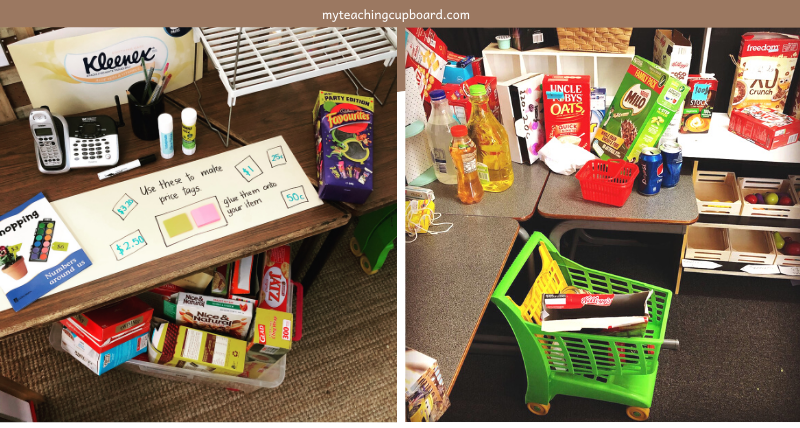
The Australian Curriculum provides us with even more detailed descriptions of the proficiencies for each level from Foundation Stage to Grade 2.
Foundation Year Level
understanding includes connecting names, numerals, and quantities
fluency includes readily counting numbers in sequences, continuing patterns, and comparing the lengths of objects
problem-solving includes using materials to model authentic problems, sorting objects, using familiar counting sequences to solve unfamiliar problems, and discussing the reasonableness of the answer
reasoning includes explaining comparisons of quantities, creating patterns, and explaining processes for indirect comparison of length.

Grade 1 Level
understanding includes connecting names, numerals and quantities, and partitioning numbers in various ways
fluency includes readily counting number in sequences forwards and backwards, locating numbers on a line and naming the days of the week
problem-solving includes using materials to model authentic problems, giving and receiving directions to unfamiliar places, using familiar counting sequences to solve unfamiliar problems and discussing the reasonableness of the answer
reasoning includes explaining direct and indirect comparisons of length using uniform informal units, justifying representations of data, and explaining patterns that have been created.
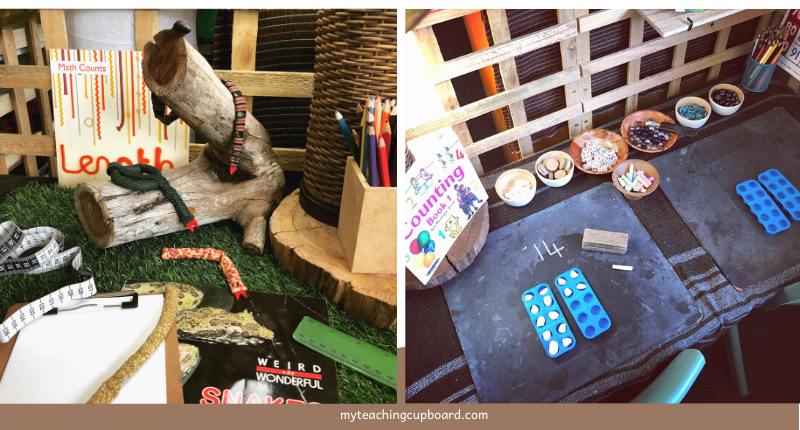
Grade 2 Level
understanding includes connecting number calculations with counting sequences, partitioning, and combining numbers flexibly and identifying and describing the relationship between addition and subtraction and between multiplication and division
fluency includes readily counting numbers in sequences, using informal units iteratively to compare measurements, using the language of chance to describe outcomes of familiar chance events, and describing and comparing time durations
problem-solving includes formulating problems from authentic situations, making models and using number sentences that represent problem situations, and matching transformations with their original shape
reasoning includes using known facts to derive strategies for unfamiliar calculations, comparing and contrasting related models of operations and creating and interpreting simple representations of data.
https://www.australiancurriculum.edu.au/
When you dive deep into the content of the F-2 ACARA Math curriculum, there sure is a lot we must cover. I have designed some illustrated learning intentions for Foundation stage. There are 159 of them!
Designing this math resource made me painfully aware how crammed our curriculum is.

Use these illustrated learning intentions to help you explicitly teach the key understandings and math content for the Foundation level. I love these for the younger students.
Written learning intentions can be somewhat ineffective because little preppies are just not confident readers yet. When you refer to the written learning intention on display, all your little ones see is a collection of letters.
For this reason, I like to use illustrated learning intentions in my classroom. These learning intentions with the pictorial representations help students remember and understand their learning goals. The pictures act as a visual prompt and help them remember and better understand their WALT goals.

There’s just not enough hours in the school day to effectively cover all those learning intentions – unless you implement a play based learning pedagogy.
Teaching Math Through Play Based Learning
A play-based pedagogy is grounded in experiences where children can explore, investigate, create, talk about, negotiate, discover, sort, count, measure, estimate, problem solve and think.
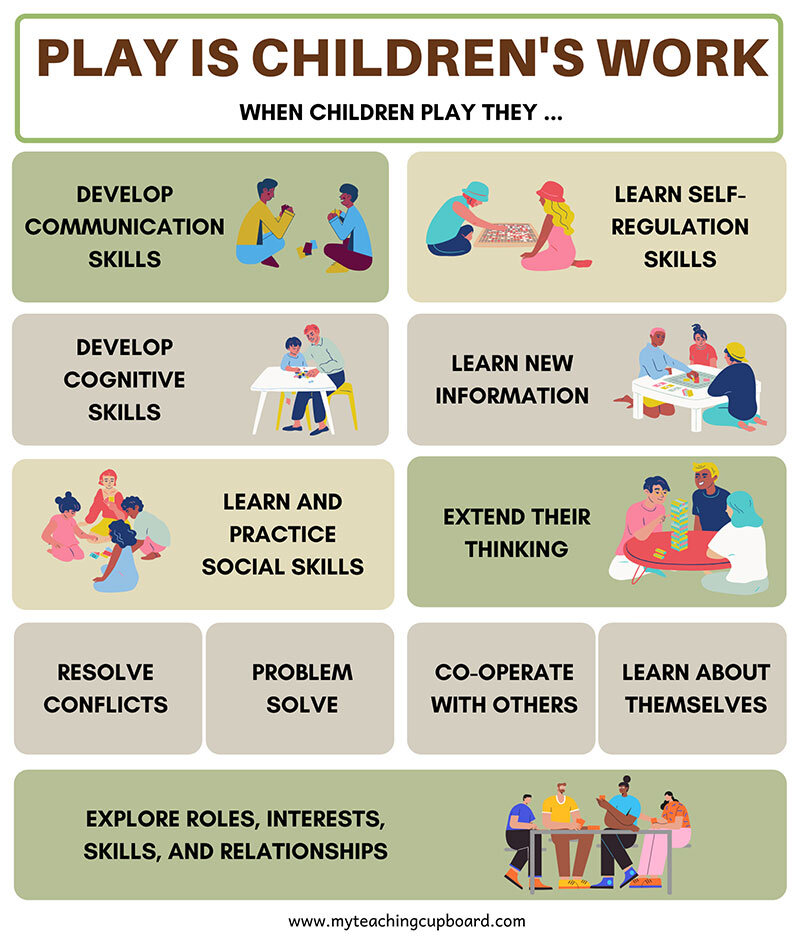
Open ended play-based learning experiences give children the chance to learn maths in a hands-on way. All teachers know there is no better way to teach math in the early years than through hands-on learning experiences.
A play-based curriculum reflects a hands-on approach to learning where children are immersed in authentically rich experiences which promote numeracy.
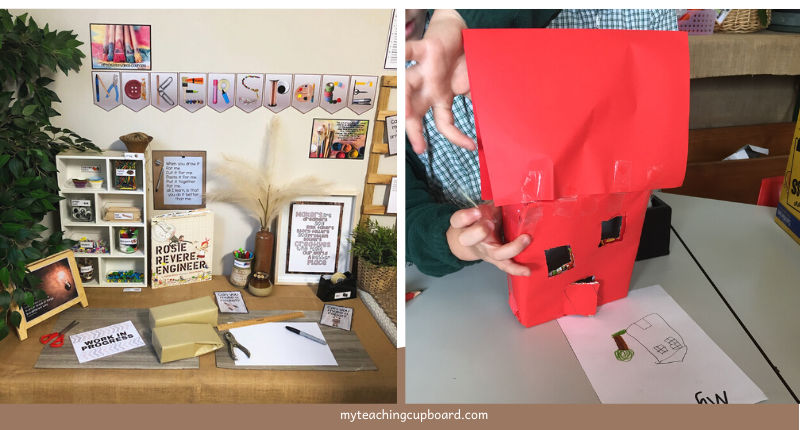
The Box Construction Area or Makerspace is a great example of how children can experience a rich range of numeracy learning experiences through play.
Many math skills are developed in the process of working in this space. First of all, the child has to make the decision to go to this area to work and then decide what they can construct with the resources there. (problem solving) They need to negotiate and find a space at the table to work. (spatial awareness)
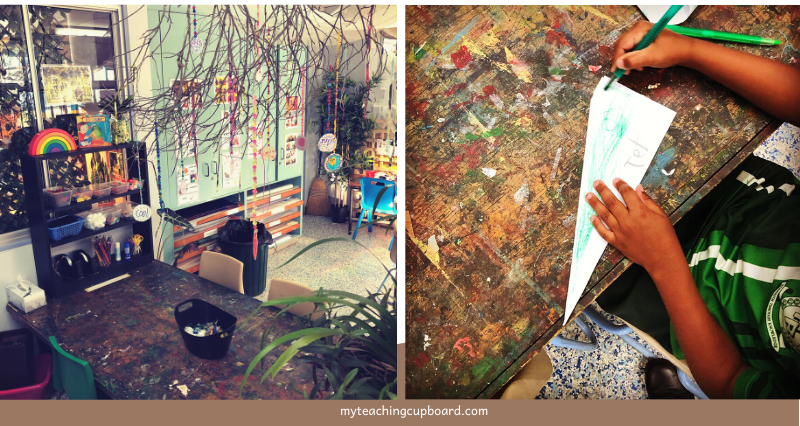
Then the child needs to make a series of mathematical decisions about their construction. She will estimate, sort, count and problem solve as she conceptualises the construction.
You might notice her measuring the size of the boxes, sorting shapes, estimating, or measuring out lengths of tape and string, experimenting with positioning and developing mathematical language.
Providing a range of play experiences in your classroom can promote numeracy skills like
Reasoning and Problem solving
Classifying, Grouping and Sorting
Patterning and Counting
Estimating and Measuring
Recognising, Distinguishing and Symbolising
Comparing and Contrasting
Representing their thinking mathematically
Teaching math through playful learning experiences doesn’t need to be difficult. Play based learning is automatically differentiated, engaging and purposeful. Children will develop and learn math concepts and skills naturally through play.

All you need to do is provide open ended resources and the time and a space for your children to explore and investigate. Trust your children.
Math Resources for Play Based Learning
I have designed a number of hands-on play based math resources you might be interested in. From investigation prompts to signs and posters, you will find a great selection to help you teach math sklls and concepts HERE .

Remember numeracy is supposed to be meaningful and a relevant part of everyday life for children in the F-2 grades. Our role is to not only teach maths but to build positive attitudes about numeracy.
Our children need and deserve to have the opportunity to learn through playful experiences that support and promote numeracy and all other aspects of their learning and development. Please don’t rely on formal and structured numeracy lessons alone.

If you found this blog post on teaching the F-2 ACARA Math learning intentions through play helpful or interesting, please consider sharing it…
Just CLICK the sharing box below.👇
Planning tool
Year levels.
- {{PlanningToolMenuItem.Name}}
Expected level of development
Australian Curriculum Mathematics V9 : AC9M2N05, AC9M2N06
Numeracy Progression : Additive strategies: P7, Multiplicative strategies: P5, Understanding money: P3
At this level, students use mathematical modelling to solve practical problems involving additive and multiplicative situations, including money transactions; represent situations and choose calculation strategies; interpret and communicate solutions in terms of the situation.
Provide novel contexts, such as story problems and challenging tasks, to apply and consolidate key understandings. Story problems involving additive and multiplicative situations can emerge from recent classroom experiences, discussions or stories read. Include opportunities to model sharing and grouping in games from a variety of cultures.
Create opportunities to model situations through role-play, including scenarios involving money transactions using whole dollar amounts. For instance, set up a shop and engage students in buying and selling groceries where students decide whether to use addition, subtraction, multiplication or division to solve purchasing problems.
Regularly explore ‘What if…?’ scenarios, such as ‘What if we had 100 tokens to share out equally among class members? How many would we each get?’ Include financial situations like ‘What if each member of our class was sponsored $5 for the reading challenge? How much money would we make altogether as a class?’
Explore various ways to model problems including using physical and virtual materials and a think board diagram. Be explicit about the value of mathematical modelling for confidently representing and communicating thinking and ideas.
There is an opportunity to connect existing knowledge and skills in addition and subtraction (AC9M2A02, AC9M2N04) and multiplication and division (AC9M2N05).
Teaching and learning summary:
- Explore and model additive and multiplicative situations that are meaningful to students.
- Build habits of reasoning by inviting students to think about solving a problem in more than one way.
- Ensure a playful culture of learning where mistakes and time for sense-making are seen as valuable to learning.
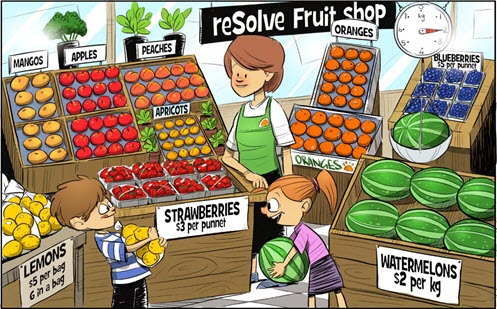
- decide whether to use addition, subtraction, multiplication or division in a given situation, and provide reasoning
- model and solve simple money problems involving whole dollar amounts with addition, subtraction, multiplication or division
- model and solve problems involving sharing and decide what to do when there is a remainder.
Some students may:
- not yet grasp that assigned money values don’t necessarily relate to size or colour. To help address this, hold regular conversations that build on existing knowledge of fairness. For instance, ask: Would it be fair for me to give you this $1 coin in exchange for that $2 coin? Why/why not?
- have trouble interpreting a problem due to the literacy demands involved. To help address this, use problems that are accompanied by visual representations. Another strategy is to use photos involving number, for example, a scene with countable animals and provide key language such as ‘whole group’, ‘altogether’ and ‘how many’ to invite students to generate their own story problems. This is one way of building understanding and language over time.
- have trouble interpreting exactly what a problem is asking. To address this, provide regular opportunities to ask questions that give less information than is required to solve the problem. For instance: Martin bought an apple. How much change did he get from $5? Questions like this with incomplete information provoke discussions that involve thinking deeply about the situation. Over time, these deep-thinking opportunities about contexts will support general ability to solve everyday problems.
The Learning from home activities are designed to be used flexibly by teachers, parents and carers, as well as the students themselves. They can be used in a number of ways including to consolidate and extend learning done at school or for home schooling.
Learning intention
- We are learning to solve everyday problems that involve making calculations.
Why are we learning about this?
- We use addition, subtraction, multiplication and division in everyday life.
1. Play with numbers as they come up in the environment, for example:
- 'I spot a number plate with the numbers 5, 4 and 8 on it. What would those numbers make added together? (5 + 4 + 8)
- I spot the house number 39. I wonder: How many more is 50 than 39? What about 70? Or 100?'
2. Link addition and subtraction to everyday situations, for example:
- Notice and discuss situations involving addition and subtraction in storybooks.
- Discuss the scores in a game of sport and talk about the difference between scores, for instance, how much the winning team has won by.
- Provide opportunities to play with, sort and add up money. Engage in imaginary situations involving paying and working out change.
- When shopping, or when playing shops, talk about the total number of items in the basket, for example, 'There are 8 apples, 6 bananas and 5 oranges. How many pieces of fruit altogether?'
- When making money calculations, use whole dollar amounts, for example, 'The milk costs $3, the bread costs $3 and the bananas cost $4. So altogether, how much do we need to pay? If we pay with a $10 note, how much change will we get? What if we pay with a $20 note?'
3. Think about and discuss different ways of solving everyday number problems. For example, to solve 17 + 6 you might decide to:
- count up from 17 using two jumps of 3 (17… 20… 23!)
- break the 6 up into 3 and 3 to make a ‘friendly 20’, 17 + 3 = 20, then 20 + 3 = 23
- start with a known doubles fact of 6 + 6 = 12, then add 11 more to get 23.
Know that mistakes are a normal part of building mathematical understanding. Be curious about mistakes and see them as opportunities to learn. Take plenty of time to solve problems.
Success criteria
- think about what’s happening in a situation and explain how I might solve it
- use my knowledge of number and making calculations to work through everyday situations
- consider whether an answer seems correct by thinking carefully about the situation
- repeat the process of solving a problem if it doesn’t seem right.
Please note: This site contains links to websites not controlled by the Australian Government or ESA. More information here .
Go to section
Teaching strategies.
A collection of evidence-based teaching strategies applicable to this topic. Note we have not included an exhaustive list and acknowledge that some strategies such as differentiation apply to all topics. The selected teaching strategies are suggested as particularly relevant, however you may decide to include other strategies as well.
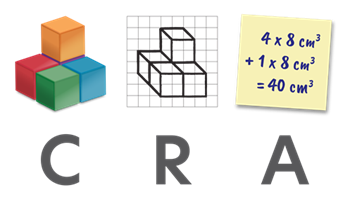
Concrete, Representational, Abstract (CRA model)
The CRA model is a three-phased approach where students move from concrete or virtual manipulatives, to making visual representations and on to using symbolic notation.
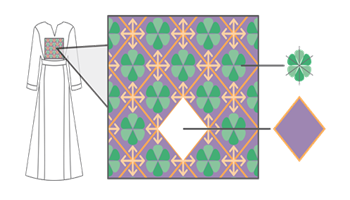
Culturally responsive pedagogy
Mathematics is not an exclusive western construct. Therefore, it is important to acknowledge and demonstrate the mathematics to be found in all cultures.
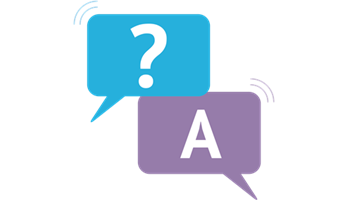
Questioning
A culture of questioning should be encouraged and students should be comfortable to ask for clarification when they do not understand.
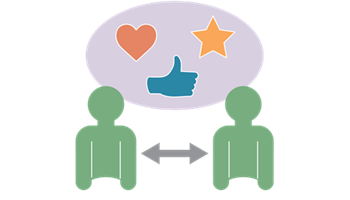
It has been shown that good feedback can make a significant difference to a student’s future performance.
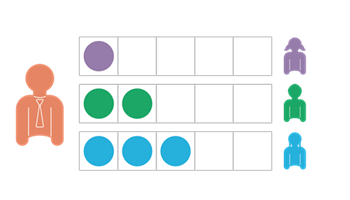
Classroom talks
Classroom talks enable students to develop language, build mathematical thinking skills and create mathematical meaning through collaborative conversations.

Collaborative learning
For group work to be effective students need to be taught explicitly how to work together in different settings, such as pairs or larger groups, and they need to practise these skills.
Teaching resources
A range of resources to support you to build your student's understanding of these concepts, their skills and procedures. The resources incorporate a variety of teaching strategies.
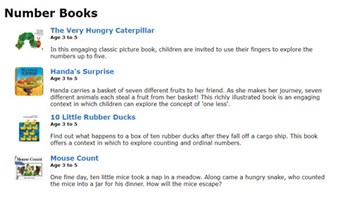
Number books
Use various titles to explore everyday and imaginary situations involving number. Invite students to identify and pose number problems to model and solve.
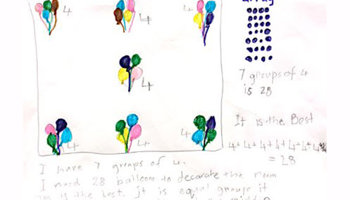
Authentic Problems: Bunches of Balloons
Use an authentic context of decorating the classroom to explore and model grouping 29 balloons.
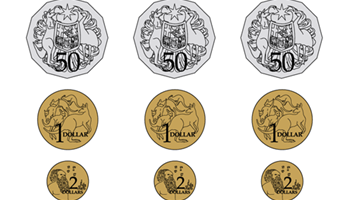
Understanding Australian coins
In this lesson students learn about Australian coins, their features, and their value.
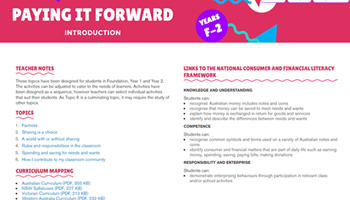
Paying It Forward Years F-2
In this unit students develop understanding about the pros and cons of saving and spending and the skill of prioritising choices based on needs and wants.

Meaning of multiplication symbols
Students use additive strategies to solve multiplication and division problems.

Shared fruit
Use this task as a mathematical modelling opportunity to find an unknown number.

Games on all fields
Use this challenging problem as an authentic opportunity to use counting strategies and mathematical modelling.
Relevant assessment tasks and advice related to this topic.
By the end of Year 2, students use mathematical modelling to solve practical additive and multiplicative problems, including money transactions, representing the situation and choosing calculation strategies.
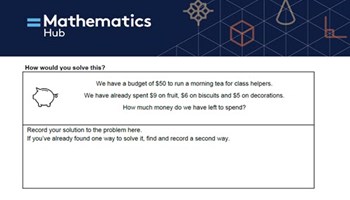
How would you solve this?
Use this open-ended task to gauge how students approach problems in addition and subtraction.
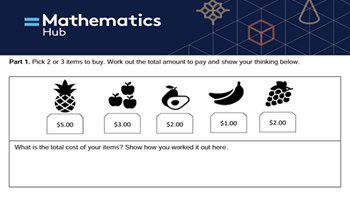
Assessment: Year 2: Fruit shopping
Use this task to gain insight into student ability to independently navigate situations involving money.

More Than a Word Problem - Problem Solving in Primary Maths
Join us for an insightful session where we explore creative ways to support the teaching and learning of problem solving in primary maths.
Date and time
About this event.
- Event lasts 1 hour
Welcome to More Than a Word Problem - Problem Solving in Primary Maths ! Join us for an engaging online event where we will explore different strategies for problem solving in primary mathematics.
During this event, we will cover various different types of problem solving, sharing tips and tricks to help you integrate them into the maths curriculum, and offering strategies and practical advice for supporting your students to develop their critical thinking skills and excel in maths.
Don't miss out on this opportunity to enhance your practice for teaching maths. Mark your calendars for Tuesday 1st October 2024 at 16:00 and join us online for More Than a Word Problem - Problem Solving in Primary Maths !
- Online Events
- Things To Do Online
- Online Classes
- Online Family & Education Classes
- #mathseducation
- #twinklteachmeet
- #twinkleducation
Organized by
To revisit this article, visit My Profile, then View saved stories .
- The Big Story
- Newsletters
- Steven Levy's Plaintext Column
- WIRED Classics from the Archive
- WIRED Insider
- WIRED Consulting
OpenAI Announces a New AI Model, Code-Named Strawberry, That Solves Difficult Problems Step by Step

OpenAI made the last big breakthrough in artificial intelligence by increasing the size of its models to dizzying proportions, when it introduced GPT-4 last year. The company today announced a new advance that signals a shift in approach—a model that can “reason” logically through many difficult problems and is significantly smarter than existing AI without a major scale-up.
The new model, dubbed OpenAI o1, can solve problems that stump existing AI models, including OpenAI’s most powerful existing model, GPT-4o . Rather than summon up an answer in one step, as a large language model normally does, it reasons through the problem, effectively thinking out loud as a person might, before arriving at the right result.
“This is what we consider the new paradigm in these models,” Mira Murati , OpenAI’s chief technology officer, tells WIRED. “It is much better at tackling very complex reasoning tasks.”
The new model was code-named Strawberry within OpenAI, and it is not a successor to GPT-4o but rather a complement to it, the company says.
Murati says that OpenAI is currently building its next master model, GPT-5, which will be considerably larger than its predecessor. But while the company still believes that scale will help wring new abilities out of AI, GPT-5 is likely to also include the reasoning technology introduced today. “There are two paradigms,” Murati says. “The scaling paradigm and this new paradigm. We expect that we will bring them together.”
LLMs typically conjure their answers from huge neural networks fed vast quantities of training data. They can exhibit remarkable linguistic and logical abilities, but traditionally struggle with surprisingly simple problems such as rudimentary math questions that involve reasoning.
Murati says OpenAI o1 uses reinforcement learning, which involves giving a model positive feedback when it gets answers right and negative feedback when it does not, in order to improve its reasoning process. “The model sharpens its thinking and fine tunes the strategies that it uses to get to the answer,” she says. Reinforcement learning has enabled computers to play games with superhuman skill and do useful tasks like designing computer chips . The technique is also a key ingredient for turning an LLM into a useful and well-behaved chatbot.
Mark Chen, vice president of research at OpenAI, demonstrated the new model to WIRED, using it to solve several problems that its prior model, GPT-4o, cannot. These included an advanced chemistry question and the following mind-bending mathematical puzzle: “A princess is as old as the prince will be when the princess is twice as old as the prince was when the princess’s age was half the sum of their present age. What is the age of the prince and princess?” (The correct answer is that the prince is 30, and the princess is 40).
“The [new] model is learning to think for itself, rather than kind of trying to imitate the way humans would think,” as a conventional LLM does, Chen says.
OpenAI says its new model performs markedly better on a number of problem sets, including ones focused on coding, math, physics, biology, and chemistry. On the American Invitational Mathematics Examination (AIME), a test for math students, GPT-4o solved on average 12 percent of the problems while o1 got 83 percent right, according to the company.

The new model is slower than GPT-4o, and OpenAI says it does not always perform better—in part because, unlike GPT-4o, it cannot search the web and it is not multimodal, meaning it cannot parse images or audio.
Improving the reasoning capabilities of LLMs has been a hot topic in research circles for some time. Indeed, rivals are pursuing similar research lines. In July, Google announced AlphaProof , a project that combines language models with reinforcement learning for solving difficult math problems.
AlphaProof was able to learn how to reason over math problems by looking at correct answers. A key challenge with broadening this kind of learning is that there are not correct answers for everything a model might encounter. Chen says OpenAI has succeeded in building a reasoning system that is much more general. “I do think we have made some breakthroughs there; I think it is part of our edge,” Chen says. “It’s actually fairly good at reasoning across all domains.”
Noah Goodman , a professor at Stanford who has published work on improving the reasoning abilities of LLMs, says the key to more generalized training may involve using a “carefully prompted language model and handcrafted data” for training. He adds that being able to consistently trade the speed of results for greater accuracy would be a “nice advance.”
Yoon Kim , an assistant professor at MIT, says how LLMs solve problems currently remains somewhat mysterious, and even if they perform step-by-step reasoning there may be key differences from human intelligence. This could be crucial as the technology becomes more widely used. “These are systems that would be potentially making decisions that affect many, many people,” he says. “The larger question is, do we need to be confident about how a computational model is arriving at the decisions?”
The technique introduced by OpenAI today also may help ensure that AI models behave well. Murati says the new model has shown itself to be better at avoiding producing unpleasant or potentially harmful output by reasoning about the outcome of its actions. “If you think about teaching children, they learn much better to align to certain norms, behaviors, and values once they can reason about why they’re doing a certain thing,” she says.
Oren Etzioni , a professor emeritus at the University of Washington and a prominent AI expert, says it’s “essential to enable LLMs to engage in multi-step problem solving, use tools, and solve complex problems.” He adds, “Pure scale up will not deliver this.” Etzioni says, however, that there are further challenges ahead. “Even if reasoning were solved, we would still have the challenge of hallucination and factuality.”
OpenAI’s Chen says that the new reasoning approach developed by the company shows that advancing AI need not cost ungodly amounts of compute power. “One of the exciting things about the paradigm is we believe that it’ll allow us to ship intelligence cheaper,” he says, “and I think that really is the core mission of our company.”
You Might Also Like …
In your inbox: The best and weirdest stories from WIRED’s archive
How the brain decides what to remember
The Big Story: Meet Priscila, queen of the rideshare mafia
Silicon Valley's soulless plutocrats flip for Donald Trump
Event: Join us for The Big Interview on December 3 in San Francisco

- MyU : For Students, Faculty, and Staff
CSpotlight: Staying Connected Through Student Groups

Why did you choose to pursue a degree in computer science specifically at the University of Minnesota?
I guess my whole interest in computer science and data science started in high school when I first took AP Computer Science Principles. That was the only computer science (CS) class that my high school offered and it was my first introduction to problem-solving using code. In one of our units, we read about how Target was able to find out which customers were pregnant using shopping data. The goal was for Target to direct its ads to pregnant women based on their pregnancy cycle. That was interesting to me - being able to take a bunch of numbers and data, being able to understand it, and then add business value. Data science was really interesting to me, so I decided to major in it. I specifically came to the University of Minnesota because my home is Minnesota and I thought that for my bachelor's degree, that's a really good option. Coming here is financially feasible, and all of my friends are here.
How did you become interested in computer science? What are your specific interests within the field?
It was the Computer Science Principles class that initially sparked my interest, specifically that case study I did. I guess in general being able to use so many different areas of school like math, statistics, and problem-solving really interested me. I just think being able to understand that logic in those areas was cool and things like algorithms and machine learning are super interesting. Those kinds of courses interest me, as well as the idea of taking such a complex idea or name, and being able to know how to translate it down to the basic ideas of math behind it.
Congratulations on earning the James Parker Memorial scholarship! How will this scholarship impact your academic and extracurricular work?
I’ll definitely have some more time to work on my own goals and not have to worry about financial stress. Part of that is that I want to be way more involved in extracurricular activities and give back. I will be working part-time next semester and I want to continue doing research. I’m also a part of the Science and Engineering Student Board (SESB), and of course, I can focus on my coursework more, too. One of the biggest things that I value is understanding what I’m learning. It’s really hard when you have so many credits and can only get to the surface level of understanding things, do assignments, and just check boxes. With the extra time, I will be able to digest the material and maybe be able to read things in my own time. It will be nice to be able to learn more without trying to figure out how to get a job to support myself financially for college.
Tell us more about your internship experiences.
I’ve had two internships - one last year and one this past summer. They were both with Allianz Technology, which is an insurance company. Last year I worked in project management, which is not a traditional thing for a computer science or data science major to do. There was a lot of crossover in terms of problem-solving and organization. With coding, you have to be organized and know how to logically solve a problem. In project management, you do that with a business lens. It was interesting to see those parallels. This year I’m working with the same company but a different team. I am working on analysis work with artificial intelligence (AI) tools.
Are you involved in any student groups? What inspired you to get involved?
As a freshman, we had the fall activities fair and ExploreU event during welcome week where you walked around the whole Huntington Bank stadium and Mariucci Area to look at different clubs on campus. It was kind of overwhelming to see all those clubs. I knew I wanted to do something that involved leadership experience and advocacy because those are two of the main pillars that I was involved with in high school and I wanted to translate that into college. I thought that something like a student board, even though I haven’t had that experience before, would have a similar leadership or advocacy position. I heard the president of SESB talk at the activities fair and orientation. I immediately signed up, became a committee member, and slowly started exploring different positions over the years. I was the K-12 outreach director at some point and I was the Recruitment and Retention director last year, which involves recruiting freshmen and being at freshman orientation fairs. This year, I’m going to be the Communications director on the executive board, focusing more on communication and newsletters and being able to foster connections with different student groups.
What do you hope to contribute to the computer science community at the University?
One of the things I’m interested in is AI, specifically how we can use and integrate AI into the curriculum. I was doing that with my internship as well, and I think with the changing landscape of technology, it’s more important to not disregard AI. AI has been controversial for its use in cheating and plagiarism, but there should also be a way for us to adapt and use AI in educational settings. I think being able to understand more about how AI works, the risks associated with it, and how to best share that with people is what I’m interested in doing.
Have you been involved with any research on campus?
I am currently researching under Dr. Harmanpreet Kaur's lab. I started in January. It’s been an insightful experience. It’s different from an internship or a job because research is determined by your results and the process itself is very different. I’ve learned a lot about the research process and a lot about the analyzed data and how to pick the right data. We are currently exploring the effect of human personality on human AI and decision-making insights.
What advice do you have for incoming computer science students?
Don’t shy away from the fact that you may not know everything. That is something I faced when I went into computer and data science. I would think, “Oh I’m kind of good at this.” Then I got to a classroom and people asked questions and I had no clue what they were saying because they already had more prior knowledge than me. In general, you need to understand that not everyone has the same knowledge base, and it shouldn't stop you from pursuing a career in something like computer science just because you feel a sense of imposter syndrome. Computer and data science is the way to go at this point - everything is data and everything is numbers and bits. Being able to understand this field is important and you shouldn't feel held back because other people seem to know more than you. So just being open to learning, and open to trying new things in general. Make sure that the curiosity to learn is there even though you don’t always feel comfortable.
What are your plans after graduation?
After graduation, I'm thinking of going straight into the industry. I'm not sure which industry yet, and I think it will be dependent on what opportunities come my way. I think after a few years working in the industry I’d like to go to grad school. I’m not sure for what yet, but I could do an MBA or a master's in data science. I think that work experiences and being in that environment will help me decide which path I want to take.
Are there any additional experiences you did that you would like to highlight in the article?
Another piece of advice is to have fun. It’s easy to get caught up in a lot of things, especially as students in CS&E. Everyone is trying to do their best, and I think all of us are naturally achievers. It helps to not get caught up in that and being able to pull ourselves back and reflect and reassure ourselves that everything is fine. You don't need to compare yourself to other people. Just have fun with the process because these four years are a time where you get to explore yourself. Don’t be hesitant and see what you have to offer.
Related news releases
- Internship Spotlight: Finding a Love for Consulting
- Internship Spotlight: The Importance of Asking Questions
- Internship Spotlight: Learning to Communicate
- Internship Spotlight: Learning About New Opportunities By Reaching out to Others
- Internship Spotlight: Multiple Majors into One Career
- Future undergraduate students
- Future transfer students
- Future graduate students
- Future international students
- Diversity and Inclusion Opportunities
- Learn abroad
- Living Learning Communities
- Mentor programs
- Programs for women
- Student groups
- Visit, Apply & Next Steps
- Information for current students
- Departments and majors overview
- Departments
- Undergraduate majors
- Graduate programs
- Integrated Degree Programs
- Additional degree-granting programs
- Online learning
- Academic Advising overview
- Academic Advising FAQ
- Academic Advising Blog
- Appointments and drop-ins
- Academic support
- Commencement
- Four-year plans
- Honors advising
- Policies, procedures, and forms
- Career Services overview
- Resumes and cover letters
- Jobs and internships
- Interviews and job offers
- CSE Career Fair
- Major and career exploration
- Graduate school
- Collegiate Life overview
- Scholarships
- Diversity & Inclusivity Alliance
- Anderson Student Innovation Labs
- Information for alumni
- Get engaged with CSE
- Upcoming events
- CSE Alumni Society Board
- Alumni volunteer interest form
- Golden Medallion Society Reunion
- 50-Year Reunion
- Alumni honors and awards
- Outstanding Achievement
- Alumni Service
- Distinguished Leadership
- Honorary Doctorate Degrees
- Nobel Laureates
- Alumni resources
- Alumni career resources
- Alumni news outlets
- CSE branded clothing
- International alumni resources
- Inventing Tomorrow magazine
- Update your info
- CSE giving overview
- Why give to CSE?
- College priorities
- Give online now
- External relations
- Giving priorities
- CSE Dean's Club
- Donor stories
- Impact of giving
- Ways to give to CSE
- Matching gifts
- CSE directories
- Invest in your company and the future
- Recruit our students
- Connect with researchers
- K-12 initiatives
- Diversity initiatives
- Research news
- Give to CSE
- CSE priorities
- Corporate relations
- Information for faculty and staff
- Administrative offices overview
- Office of the Dean
- Academic affairs
- Finance and Operations
- Communications
- Human resources
- Undergraduate programs and student services
- CSE Committees
- CSE policies overview
- Academic policies
- Faculty hiring and tenure policies
- Finance policies and information
- Graduate education policies
- Human resources policies
- Research policies
- Research overview
- Research centers and facilities
- Research proposal submission process
- Research safety
- Award-winning CSE faculty
- National academies
- University awards
- Honorary professorships
- Collegiate awards
- Other CSE honors and awards
- Staff awards
- Performance Management Process
- Work. With Flexibility in CSE
- K-12 outreach overview
- Summer camps
- Outreach events
- Enrichment programs
- Field trips and tours
- CSE K-12 Virtual Classroom Resources
- Educator development
- Sponsor an event

COMMENTS
Standard/Learning Intention Success Criteria Mathematics 9 Standard: Model and solve problems, using linear equations of various forms. Learning Intention: I am learning to solve linear equations. I can solve two-step equations. I can isolate the variable in the equation. I can explain the process of solving an equation.
Research Behind Deep-Level Learning - Reasoning and Problem Solving in Mathematics . ... As outlined in this blog and the prior blog, the use of learning intentions and success criteria are vital in providing instructional practice that offers students clear and purposeful goals and a foundation for what success looks like. The learning ...
1. Link problem-solving to reading. When we can remind students that they already have many comprehension skills and strategies they can easily use in math problem-solving, it can ease the anxiety surrounding the math problem. For example, providing them with strategies to practice, such as visualizing, acting out the problem with math tools ...
Starting with a prompt - either a picture or a question - students can explore different ways of approaching the problem and communicating their thinking. Mathematics investigation links directly to the Critical and Creative Capability in the Australian Curriculum (Version 9.0). Investigations can be differentiated by adjusting the ...
Standard/Learning Intention Success Criteria. Mathematics 9 ... I can solve two-step equations. I can isolate the variable in the equation. I can explain the process of solving an equation. I can apply the distributive property. I can change an equation into a function. ... Mathematics Kindergarten to Grade 9: Patterns and Relations. Edmonton ...
When teachers adopt explicit teaching practices, they ensure students know what to do and why. The teacher plans the learning intentions and success criteria, makes them clear to students, and ensures they are modelled. By the end of the learning sequence, student understanding is validated and planned mathematical connections are established.
Schema approach. This is a math intervention strategy that can make problem solving easier for all students, regardless of ability. Compare different word problems of the same type and construct a formula, or mathematical sentence stem, that applies to them all. For example, a simple subtraction problems could be expressed as:
problem-solving approaches, and/or metacognitive strategies) to support working toward given learning intentions and success criteria in mathematics. For example, a student might respond to feedback, saying, "There is a more efficient way to solve this quadratic equation.
The teacher uses questioning techniques that encourage students to select or develop their own approaches to solving the maths problems. The teacher tracks student progress against the lesson's success criteria as a means of responsive, ongoing assessment. Particular note is made of any student misconceptions.
A set of Learning Intention cards, perfect to display in the classroom to promote visible learning and explicitly show students what their learning goals are for a particular concept.. These learning intention cards have been written using the Mathematics Content Descriptions found in the Australian Curriculum v8.3 and have been created to use with our We're Aiming High - Bump It Up Data ...
Introduction to problem solving approach. Share the learning intention and success criteria using Slide 3. ... Explain that today we will be solving a maths problem related to pocket money. To help us, we will follow a 4-step method to guide our work and thinking. Introduce each of the steps to the students over the course of the lesson.
These align to the learning in the series and teaching notes and provide teachers with a great starting point in setting goals and creating clarity when teaching and learning mathematics. Hattie (2012) believes that the key to setting learning goals and provid ing success criteria is to help students commit to the learning and provide the ...
John Hattie explains the importance of sharing learning intentions. The basic premise is that the students have the same idea as their teacher what is going on in the classroom, and what they should be learning as a result of doing. Many students are not going to know this unless it is clearly signposted - learning intentions (or objectives), and learning outcomes (or success criteria) provide ...
Statistic coefficients for "the intentions of middle school students with regard to learning of mathematics" By learning mathematics I intend: to acquire theoretical mathematics knowledge to improve my calculation skills to form the capacity to reason and solve a problem N Valid 350 349 349 Missing 0 1 1 Mean 4,0143 4,5186 4,8911 Median 4,0000 ...
Understand the problem: Students reread the problem carefully, summarize and rewrite the information in mathematical notation, use keyword analysis, draw a picture or a diagram, or even act out the scenario. Devise a plan: Looking for patterns and solving a simpler problem are my favorite approaches, but other ideas—guess-and-check, working backward, eliminating possibilities, using a ...
This Maths Learning Intention and Success Criteria Editable PowerPoint contains adaptable, child-friendly templates. You can change them for each of your maths lessons to suit the needs of your children and the aims of the lesson. It includes templates for l earning intentions, prompts for children to use while working, self-assessment and ...
Brief. Problem solving plays an important role in mathematics and should have a prominent role in the mathematics education of K-12 students. However, knowing how to incorporate problem solving meaningfully into the mathematics curriculum is not necessarily obvious to mathematics teachers. (The term "problem solving" refers to mathematical ...
Zone of Confusion. Peter Sullivan uses the Launch, Explore, Summarise Framework to illustrate how to teach using a problem-solving approach. While lesson sequences should be challenging, Peter discusses launching the task so that students are within their "zone of confusion".This does not mean that students should be experiencing learning that is beyond their capability, merely that the task ...
Model place value partitioning strategies to multiply larger numbers by one-digit and two-digit numbers. For example, to multiply 24 x 12, first multiply 10 x 24 and then multiply 2 x 24 and add the two products together. Use area models and arrays to show partitioning. Make explicit how factors can be used to simplify calculations.
Every classroom even has a formula—a problem-solving plan for math, printed out and displayed on the wall—called the "Plan of Attack," which includes three parts: using 80 percent of the allotted time to conceptualize the question by reading the problem multiple times, then modeling the relationships and actions in the problems; 10 ...
The learning intention for all three Number Talks was, "We are learning to see combinations of 7.". The success criteria for the first Number Talk using ten-frames was, "I can share how my friend saw seven.". The second Number Talk used domino dot patterns and the success criteria was, "I can compare how our thoughts are the same and ...
Learning mathematics is a dynamic procedure that requires preparation and readiness. ... which could explain a positive relationship between achievement in high-level math courses and the students' intention to retain in the college or their major. ... developing enhanced problem solving-skills and prefer logical and critical thinking skills.
The key ideas and understandings of the ACARA Math Curriculum are closely integrated and should be taught in an integrated way. Play based investigations are ideal for integrating the content strands and the key ideas. In Mathematics, the key ideas are the proficiency strands of understanding, fluency, problem-solving and reasoning.
It identifies the level of students' problem-solving skills in their pretest and post-test and whether there is a significant difference between the result of students exposed to GAI and those ...
Frameworks for Mathematical Problem Solving. One widely accepted and useful definition of a mathematical problem is that a problem exists when the procedure for solving the task is unknown to the solver, the number of solutions is uncertain, and the task requires critical thinking (Schoenfeld, Citation 2011).Word problems are a type of problem that are frequently found in classroom instruction.
Teaching and learning summary: Explore and model additive and multiplicative situations that are meaningful to students. Build habits of reasoning by inviting students to think about solving a problem in more than one way. Ensure a playful culture of learning where mistakes and time for sense-making are seen as valuable to learning.
Welcome to More Than a Word Problem - Problem Solving in Primary Maths!Join us for an engaging online event where we will explore different strategies for problem solving in primary mathematics. During this event, we will cover various different types of problem solving, sharing tips and tricks to help you integrate them into the maths curriculum, and offering strategies and practical advice ...
Oren Etzioni, a professor emeritus at the University of Washington and a prominent AI expert, says it's "essential to enable LLMs to engage in multi-step problem solving, use tools, and solve ...
I guess in general being able to use so many different areas of school like math, statistics, and problem-solving really interested me. I just think being able to understand that logic in those areas was cool and things like algorithms and machine learning are super interesting. Those kinds of courses interest me, as well as the idea of taking ...